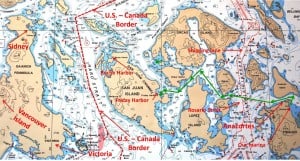Monday, June 10; Anacortes Marina to Friday Harbor SYC Outstation. The cruise over to Friday Harbor was short, sweet, and uneventful – at 2 hours, 18 minutes total time. As you can see on the chart at right, our route took us due west across Rosario Strait, where it’s vital to pay close attention for large oil tankers heading to and from the Cherry Point refinery at Bellingham and the two refineries at Anacortes and near our marina (Marathon and Shell). The shipping lane is shown on the chart in red dashed lines, and to the south it leads out to the Strait of Juan de Fuca. According to the Wikipedia page on Rosario Strait, more than 500 oil tankers pass through the strait each year, so this is indeed a busy shipping lane.
Don’t forget – you can click on any photo in the post to enlarge it.
If you want to see where we are now, or better yet, monitor our route progress as we cruise along, you can go to www.ronf-flyingcolours.com and click on the Current Location link in the upper right corner of the home page.
Also, this post is more readable in the online version, plus you can read any of the posts back to 2010 from the archive – just click on the link above to the blog.
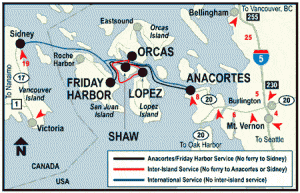
The Washington State Ferry routes through the San Juan Islands. The large blue dots indicate ferry terminals, with the main terminals being at Anacortes, Orcas, and Friday Harbor, with minor ones at Lopez and Shaw Islands. An international route is run in the summer months between Anacortes and Sidney (B.C.), with an intermediate stop in Friday Harbor.at Orcas
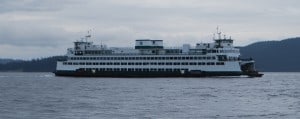
Washington State ferries are all car ferries, and tend to be behemoths. With their frequency of runs, it would be unusual if we didn't meet or get passed by four ferries on any cruise through the San Juans. We listen closely to the Vessel Traffic frequency, as the ferries report their departures from any terminal and that gives us a pretty good heads-up.
Once across Rosario Strait, and between Blakely and Decatur Islands, we transit Thatcher Pass, then turn NW to round the northern tip of Lopez Island – that nicely hides a WSF terminal that ferries suddenly pop out from.
A turn to the SW on Cattle Pass takes us to the south end of Shaw Island – and the tide that meets here as it goes around the top and bottom of the island always deposits lots of wood debris to watch out for.
It’s then a quick shot across the San Juan Channel that separates Shaw from San Juan Island. At the opening to Friday Harbor sits Brown Island, creating two entrances to the harbor, the main entrance at the north that has the WSF ferry terminal, the Customs dock, and the main downtown of Friday Harbor (for some reason, really good harbors seem to have an island that almost plugs the entrance, creating a good protection for boats moored and anchored inside). The south entrance is quite narrow and shallow, but smaller boats our size can transit it, and it takes us to the SYC “outstation” that’s located at that end of the harbor.
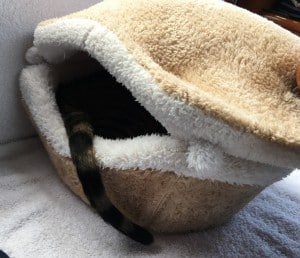
On most cruises ZuZu "goes to ground", either under a blanket or inside her covered oyster bed. She usually has something sticking out, either a paw or her tail. If we don't hear from her we assume everything's OK, but if we hear a low growling-type of meow, we know the waves are serious enough to kick off her "rough-o-meter".
Nevertheless, the crossing was smooth. It must have been, because our reliable and very vocal “rough-o-meter” – ZuZu – slept in her “oyster bed” all the way across – with her long tail sticking out. Along the way, we met the usual 3-4 Washington State Ferries, but other than having to allow for their large wakes, they aren’t a problem – being behemoths in the first place, and traveling at 23 knots, they can put up a 5’-6’ wake when they pass close by. As you can see from the accompanying Washington State Ferry map, the main terminal for the San Juan Islands is at Friday Harbor.
(If you’re not familiar with how the crazy border between the U.S. and Canada ended up with the San Juan Islands being part of the U.S., you should read about the infamous Pig War of 1859 that finally got the long-running dispute resolved in the U.S.’ favor – you can find it on the opening page of my June 23, 2018 blog post – titled Cruise 2018. . . You can find it in the Archives.)
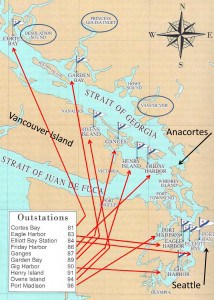
The Seattle Yacht Club is an asset-rich club, including a main clubhouse (called the Main station in club parlance) that contains two restaurants, several meeting rooms, and staff offices. The real crown jewels of the club, though, are its outstations, scattered from the lower end of Puget Sound all the way north to Desolation Sound. The use of the outstations are strictly for club members (no reciprocal privileges). Moorage at any outstation is free, and the allowable length of stay is generous (if not unlimited).
Arriving at Friday Harbor. Our late start from Anacortes put us at risk of finding the outstation full. Kap and I both had our binoculars trained on the SYC docks, hoping that our usual (and preferred) outside side-tie dock was available. Alas, it wasn’t, with a 65’ Ocean Alexander and a 55’ Ocean Sport taking up the full dock. As we got closer we could see several other inner docks open that we could fit into, and our blood pressure dropped to normal. With the help of about six people who jumped off their boats to help us dock, we were tied up in short order.
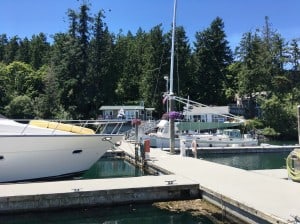
The Friday Harbor outstation is very well equipped. With moorage space for at least 20 member boats, there's also a club house, a laundry room, shower room, restrooms, and a deck area with BBQs for the club's famous "green box" appie/drink get-togethers. The main building at left in the photo is the full-time live-in outstation manager's residence.

Walking to or from the outstation on the road to town, I never tire of this view, and probably have five photographs from every one of the years we've visited the outstation. On a clear day, Mt. Baker is visible through the south entrance to the harbor, and we watch for ferries passing by the entrance. The club's moorage dock is only the furthest one away in the photo, and the near dock is for another club next door to us. Flying Colours is the third boat in, on the opposite side of the dock, with the yellow kayak slung along the side of the dinghy deck.
The Friday Harbor outstation is one of our most favorite outstations of the 11 facilities that the SYC has (including the Main Station Clubhouse at Portage Bay between Lake Washington and Lake Union). It’s almost always our first outbound and last inbound stop on each summer’s cruise. The level of facilities at each outstation are quite different, with five of the ten having full-time live-in managers that the Club employs and houses right at the outstation – and Friday Harbor is one of the five. (Three are leased dock space at privately-owned marinas, one is at an un-manned facility, and one is simply a dock alongside a very small SYC-owned island near Ladysmith (B.C.)) These outstations are the crown jewels of the Seattle Yacht Club, and for many of us who cruise a lot, they’re the single biggest reason we joined the Club. Moorage at all of the outstations is free, and easily makes up for the monthly club dues.)
The 2-day stopover was intended to be our shakedown cruise for testing any remaining systems to ensure they were working – a good solid test of the BBQ propane tanks, pinging of the satellite TV dish by Direct TV to get it working again, and check out the dinghy outboard motor to make sure it ran OK (we failed to winterize the motor when we brought it back from Lake Union so that was a critical test). On the way over, Kap felt comfortable that the new trim tab control box was working OK, but we had decided not to test out the water maker until a longer cruise (the system needs a long time to start up and shut down, so Kap didn’t feel comfortable with the short trip over from Anacortes).
At dinner, Kap found the BBQ propane tanks were again failing to supply a good propane flow to the BBQ, and in fact, it was no better than at Anacortes. Getting this resolved became the overriding task for the next morning. I asked around, and found that San Juan Propane was considered the only game in town for reliable propane service. The next morning Kap removed both tanks from their storage brackets in the fly bridge, I hauled them to the top of the steep driveway to Warbass Drive that runs by the outstation and rendezvoused with “Bob’s Taxi Service”. For a pricey $10 fare for about a mile and a half we drove to the propane shop on the edge of town. Unfortunately, the really knowledgeable propane guy was out on a long service call at Decatur Island (the closest island to the Anacortes area) and wasn’t expected back until late in the evening. The more inexperienced service guy, Chuck, was left back at the shop to hold it down, but he promised me he’d take a good look at it. Not feeling a lot of confidence that I’d get the problem sorted out in a quick day, I walked back to the boat.
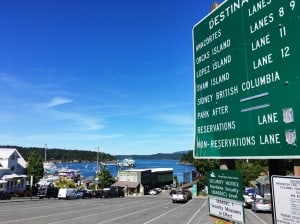
The 2PM ferry, the Elwha, was just departing for Sidney (B.C.) as I walked by with a load of groceries. The car waiting lot is oftentimes full, but this time it was almost empty. The big sign identifies the five destinations from Friday Harbor. From here it's about a 3/4 mile walk to the SYC outstation and a quarter mile to the main downtown street intersection.
When I returned, Kap was readying the dinghy for its outboard motor test. We lowered it into the water, but kept the davit hooked up to it, and Kap jumped in to see if the motor would start. The battery was fine, it cranked and started in about two seconds. After letting it run a few minutes to ensure it was pumping cooling water, we shut it down and raised it onto the dinghy deck. One more checklist item completed.
Middle of the afternoon I called the propane shop and got word that the tanks had checked out OK, and after bleeding off the overfill they were at correct pressure and I could pick them up. Another pickup by Bob’s brought me back to the propane shop – and a surprising no charge for their work – and returned to the boat with the heavy tanks. Sure enough, they ran the BBQ just fine this time, and we felt comfortable removing this from the checklist.
The big problem of the afternoon was the satellite dish pinging task. Anyone who has a satellite TV dish probably knows that if you leave the TV turned off for a period of two months or more, both of the satellite TV companies – DirecTV and Dish – consider the satellite to be inactive and they suspend access to it (but they still keep charging their monthly service fee – duh – why is that not surprising?). To restart service you have to call their 1-800 number to have them ping your system – and wouldn’t you know it, the 1-800 number only works within the U.S. – so before we cross into Canada at Sidney, we have to make sure each year that this gets done. Steeling her patience and nerves, Kap got a DirecTV technician on the phone and began what she knew would be a frustrating time of it. This time was no exception. The first box – in our salon (identified as our living room to DirecTV – was successfully pinged without a hitch and we had PBS up and running on it in a record 15-20 minutes. Then Kap had them ping the second box in our main V-berth – and it didn’t go well. The DirecTV technician finally admitted the problem was somehow out of his depth and passed the call over to someone above his pay grade. Not! The twerp cut the line off, and when Kap rang back – waiting at least a half hour in their stupid support queue – she had to go back through all of the identification rigmarole. She again spent over a half hour with someone who didn’t know any more than the first one, who then passed her “upstairs” to a supervisor. After a total of three hours on the call, getting absolutely nowhere, Kap gave up in disgust. At least we have the salon TV working (we think).
With that, it’s time to head over to Sidney – still without Kap’s Nexus card being renewed, so we’re looking at the unknown of a face-to-face Customs clearance at the marina dock. Stay tuned.

